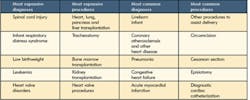Three ways to ignite coding performance.
Alice
Zentner,
RHIA
Cathy
Brownfield,
RHIA, CCS
HealthGrades. Office of the Inspector General. RAC. These are just a few of the eyes and ears of healthcare. Like a news reporter in search of a story, these industry watchdogs and others like them are peering over shoulders to uncover signs of poor patient care and fraudulent billing. Coded data is often the main source for their stories and lies at the center of their investigations.
To cope, most organizations have implemented coding compliance along with clinical documentation improvement (CDI) programs. These programs work together to ensure revenue integrity, reduce external investigations and mitigate risk. By completing the coding and billing process right the first time, organizations don't waste time fixing denied claims and can more easily reduce operational costs. Finally, a strong compliance program also ensures a facility is on track and equipped to handle the new requirements of the ICD-10 code set.
If your organization's coding and CDI programs are producing less than satisfactory results or coding errors continue to cause revenue loss, it's time for a tune-up. There are three starting points for better coding compliance: unspecified codes, high-cost/high-volume conditions and underperforming MS-DRGs (Medicare severity diagnosis related group).
Top 5 hospital diagnoses and procedures*
*Hospital Inpatient Statistics, 1996, Healthcare Cost and Utilization Project Research Note. AHCPR Publication No. 99-0034. Agency for Health Care Policy and Research, Rockville, Md.
The perils of unspecified codes
Vague, incomplete and non-specific documentation is one of the most common challenges facing clinical coders today. Unspecified documentation leads to unspecified codes. And unspecified codes cause a myriad of revenue cycle problems, including heightened need for internal audits. Secondly, unspecified codes draw down the case mix index (CMI) and negatively impact severity and risk scores such as those reported on HealthGrades.
Recent audits comparing the same records coded in ICD-9 and ICD-10 demonstrate an increased number of unspecified cases. This is because ICD-10 offers many more code choices and a deeper level of code granularity. Cases coded accurately in ICD-9 may lack the specificity needed for ICD-10, resulting in an unspecified MS-DRG.
For example, asthma in ICD-10 requires documentation of mild, moderate or severe along with intermittent or persistent. Also, coding Crohn's Disease requires much greater specificity, including presence or absence of rectal bleeding, intestinal obstruction, fistula, abscess or other complication. ICD-10 raises the bar on coding compliance and documentation. If the assignment of unspecified codes continues in ICD-10, lower reimbursements will certainly be the result.
To remedy the situation, providers should audit all cases of unspecified coding within the current coding-compliance program. For each medical specialty, identify the areas where more comprehensive documentation will be required for ICD-10. Begin physician education programs now. “Lunch and learns,” pocket cards and other small reminders can supplement peer-to-peer training efforts.
High cost and high volume are big concern
ICD-9 has 59 codes for diabetes mellitus, while ICD-10 offers more than 200. And the term “uncontrolled diabetes,” one of the nation's most common diagnoses, is not even mentioned in ICD-10. Instead, the exact manifestation of the uncontrolled diabetes must be documented and coded (e.g., diabetes with hyperglycemia). After decades of asking physicians to change how they document diabetes, the rules of the game are about to change. And diabetes is only one of the many high-volume conditions in healthcare.
Organizations can begin today by identifying the top 20 conditions for volume and cost. Once identified, coding compliance and CDI teams should partner to conduct in-depth analysis of what documentation will be needed to support accurate ICD-10 coding for these diagnoses and procedures. Similar to the efforts mentioned above, physician education and new knowledge levels for clinical coders will be required.
Specific examples should be used when educating physicians. Organizations can create charts listing a diagnosis and the ICD-10 documentation specificity needed to accurately code and bill. For example, instead of simply documenting asthma, physicians need to state the severity level of the asthma in ICD-10. So in this case, each ICD-10 severity level for asthma should be presented to the medical staff along with the type of documentation that will be required.
Yes, the changes are complex and along with them, the educational process — particularly with physicians — will be arduous. There is no time to panic, but also no time to wait, as 80 percent of an organization's revenue typically comes from their top 20 percent of cases.
Back to the basics
The Program for Evaluating Payment Patterns Electronic Report (PEPPER) is a proven starting point for boosting coding compliance. Hospitals have used PEPPER reports for decades to identify trends, monitor high-risk areas and compare themselves to other facilities from one quarter to the next. PEPPER reports are based on hospital-specific Medicare data and must be a key component of the coding-compliance program.
Specifically, organizations should look for MS-DRGs within certain major diagnostic categories that are performing at the lowest levels. Suboptimal performance compared to peers is often due to inappropriate documentation. For example, physicians often use slang terms to describe common conditions. Pneumonia may be described only as hospital acquired, community acquired, etc. By neglecting to document the organism causing the respiratory infection, a “simple” pneumonia code is used instead of a more severe or complicated code.
Once identified, these types of issues can be targeted for quality coding reviews, internal audits and education. If performance fails to improve over at least two consecutive quarters, an external audit may be conducted to obtain an unbiased, neutral third-party opinion and uncover underlying problems.
Poor performance with ICD-9 coding is a sure indicator of revenue problems in ICD-10. Organizations that start early by assessing current areas of concern, going back to the basics and conducting frequent, internal and well-documented audits, are better prepared to handle future coding requirements.
The catalyst for better ICD-9 coding
The implementation of ICD-10 is a catalyst for improved coding performance in ICD-9. The new code set will create a refined challenge related to coding and clinical documentation. Greater specificity will lead to improved patient care, more accurate reimbursement and better data about healthcare populations.
However, organizations can't leverage these benefits if the supporting documentation is unclear or incomplete.
ICD-10 requirements should be built into all ICD-9 coding compliance and CDI programs today. Programs should:
• Include standardized methods to measure coding quality performance and clinical documentation.
• Be conducted regularly.
• Incorporate both internal and external auditing practices.
By bolstering coding compliance and CDI programs now, providers should improve documentation, coding and reimbursement, reduce their risk of recovery audit take-backs and increase CMI. And they'll be ready come 2013.
Cathy Brownfield, RHIA, CCS,
is VP of operations, TrustHCS.
Alice Zentner, RHIA,
is director of ICD-10
auditing and education, TrustHCS.
For more information on TrustHCS solutions:
www.rsleads.com/107ht-202




